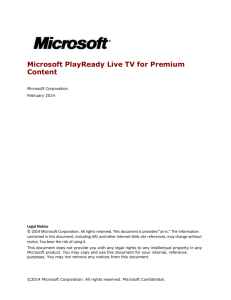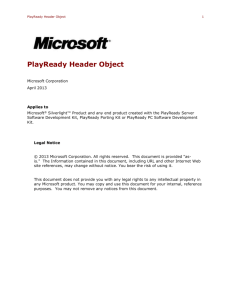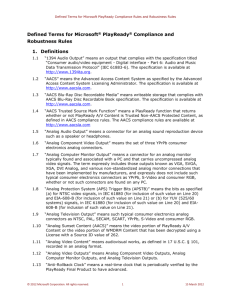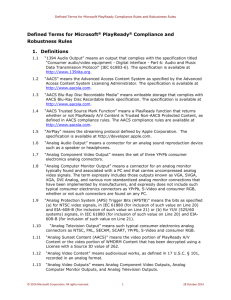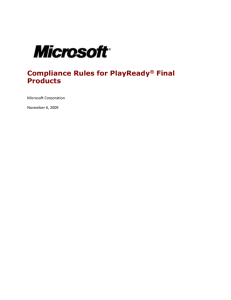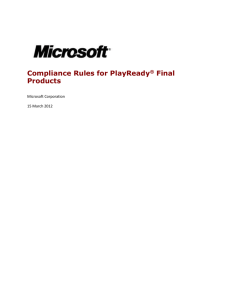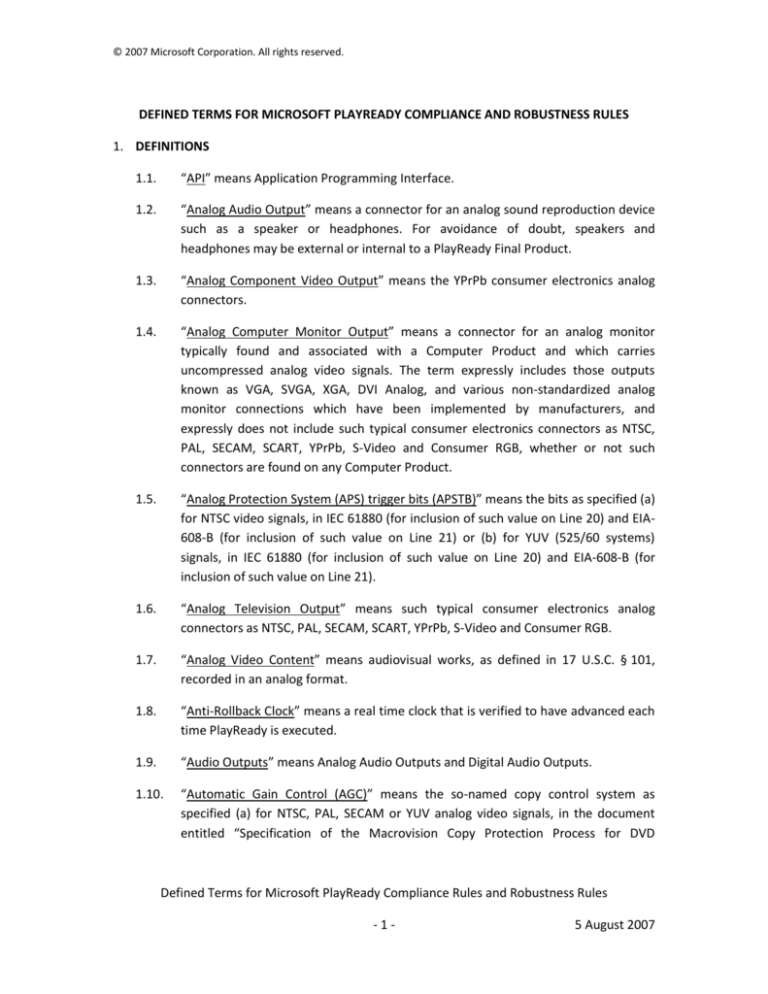
© 2007 Microsoft Corporation. All rights reserved.
DEFINED TERMS FOR MICROSOFT PLAYREADY COMPLIANCE AND ROBUSTNESS RULES
1. DEFINITIONS
1.1.
“API” means Application Programming Interface.
1.2.
“Analog Audio Output” means a connector for an analog sound reproduction device
such as a speaker or headphones. For avoidance of doubt, speakers and
headphones may be external or internal to a PlayReady Final Product.
1.3.
“Analog Component Video Output” means the YPrPb consumer electronics analog
connectors.
1.4.
“Analog Computer Monitor Output” means a connector for an analog monitor
typically found and associated with a Computer Product and which carries
uncompressed analog video signals. The term expressly includes those outputs
known as VGA, SVGA, XGA, DVI Analog, and various non-standardized analog
monitor connections which have been implemented by manufacturers, and
expressly does not include such typical consumer electronics connectors as NTSC,
PAL, SECAM, SCART, YPrPb, S-Video and Consumer RGB, whether or not such
connectors are found on any Computer Product.
1.5.
“Analog Protection System (APS) trigger bits (APSTB)” means the bits as specified (a)
for NTSC video signals, in IEC 61880 (for inclusion of such value on Line 20) and EIA608-B (for inclusion of such value on Line 21) or (b) for YUV (525/60 systems)
signals, in IEC 61880 (for inclusion of such value on Line 20) and EIA-608-B (for
inclusion of such value on Line 21).
1.6.
“Analog Television Output” means such typical consumer electronics analog
connectors as NTSC, PAL, SECAM, SCART, YPrPb, S-Video and Consumer RGB.
1.7.
“Analog Video Content” means audiovisual works, as defined in 17 U.S.C. § 101,
recorded in an analog format.
1.8.
“Anti-Rollback Clock” means a real time clock that is verified to have advanced each
time PlayReady is executed.
1.9.
“Audio Outputs” means Analog Audio Outputs and Digital Audio Outputs.
1.10.
“Automatic Gain Control (AGC)” means the so-named copy control system as
specified (a) for NTSC, PAL, SECAM or YUV analog video signals, in the document
entitled “Specification of the Macrovision Copy Protection Process for DVD
Defined Terms for Microsoft PlayReady Compliance Rules and Robustness Rules
-1-
5 August 2007
© 2007 Microsoft Corporation. All rights reserved.
Products, Revision 7.1.D1, September 30, 1999,” and (b) for a 480p progressive scan
analog video signal, in the document entitled “Specification of the Macrovision AGC
Copy Protection Waveforms for DVD Applications with 525p (480p) Progressive Scan
Outputs, Revision 1.03 (December 22, 1999).”
1.11.
“A/V Content” means PlayReady A/V Content or WMDRM Content.
1.12.
“Bluetooth Audio Profiles” means Advanced Audio Distribution Profile (A2DP) v1.0
or greater, Hands Free Profile (HFP) v1.0 or greater, and Headset Profile (HSP) v1.0
or
greater.
Bluetooth
technical
specifications
are
available
at
http://www.bluetooth.com/Bluetooth/Learn/Technology/Specifications/.
1.13.
“Certificate” means a unique PlayReady or WMDRM object used to establish trust.
1.14.
“Certificate Signing Private Key” means a Cryptographically Sound asymmetric
private key generated by Company for the purpose of signing Certificates.
1.15.
“Certificate Signing Symmetric Key” means the symmetric key derived from the
Certificate Signing Private Key.
1.16.
“CGMS-A” means the Copy Generation Management System (Analog) as specified
(a) for NTSC analog video signals, in IEC 61880 (for inclusion on Line 20) and in EIA608-B (for inclusion on Line 21), (b) for PAL, SECAM or YUV analog video signals, in
IEC 61880 (for inclusion on Line 20) or in EIA-608-B (for inclusion on Line 21) or in
EIA-805 (for inclusion on Line 41) for YUV (525/60 systems) signals or in ETS 300294
for PAL, SECAM and YUV (625/50 systems) signals, or (c) for 480p progressive scan
analog video signals, in, or adapted without material change from, EIAJ CPR1204-1
(defining the signal waveform carrying the CGMS-A) and IEC 61880 (defining the bit
assignment for CGMS-A).
1.17.
“Circumvention Device” means a hardware, software, or hybrid entity whose
primary purpose is the circumvention of one or more Content Protection Functions.
1.18.
“Clock Rollback Event” means determination by PlayReady that the current date and
time precedes the Last Known Good Date and Time.
1.19.
“ColorStripe” means the so-named copy control system as specified for NTSC analog
video signals in the document entitled “Specification of the Macrovision Copy
Protection Process for DVD Products, Revision 7.1.D1, September 30, 1999.”
1.20.
“Company” means an entity licensed under a PlayReady Agreement to develop
PlayReady Final Products.
Defined Terms for Microsoft PlayReady Compliance Rules and Robustness Rules
-2-
5 August 2007
© 2007 Microsoft Corporation. All rights reserved.
1.21.
“Computer Product” means a device that is designed or permits the end user to
install software applications thereon, including, but not limited to, personal
computers, handheld “Personal Digital Assistants,” and the like.
1.22.
“Confidential User Information” means personally identifiable information about
end users’ use of PlayReady.
1.23.
“Consistent with the Microsoft Implementation” means the PlayReady Final Product
(i) provides equivalent functionality to the Microsoft Implementation, (ii) equals or
exceeds the robustness of the Microsoft Implementation, and (iii) maintains
compatibility and interoperability with the Microsoft Implementation.
1.24.
“Content” means PlayReady Content and/or WMDRM Content.
1.25.
“Content Key” means a key used to encrypt and decrypt Content.
1.26.
“Content Protection Functions” means functions related to authentication,
encryption, decryption, Device Certificate signing, output protection, Metering,
Secure Clock, content revocation, key management, rights enforcement and
storing/updating information in the PlayReady Data Stores as such terms are
described and required in the Microsoft Implementation, to the extent such
functions are implemented in PlayReady Final Products.
1.27.
“Content Provider” means the entity that specified directly or indirectly the rights
and restrictions in a PlayReady License.
1.28.
“Content Provider Authorized Export” means a technology authorized by a Content
Provider in a Policy to enable Export.
1.29.
“Cryptographic Keys” means Content Keys, Device Keys, Device Certificate Signing
Keys, Domain Keys, Fallback Keys, License Integrity Keys, WMDRM Root Public Keys,
PlayReady Root Public Keys, Privacy Public Keys, and Session Keys.
1.30.
“Cryptographically Random” means unpredictable, in that no polynomial-time
algorithm, given any sequence of bits, can guess the succeeding K bits with
probability greater than ½^K + 1/P(K) for any (positive) polynomial P and sufficiently
large K.
1.31.
“Cryptographically Sound” means being of sufficient strength to render a
cryptanalytic attack computationally infeasible.
Defined Terms for Microsoft PlayReady Compliance Rules and Robustness Rules
-3-
5 August 2007
© 2007 Microsoft Corporation. All rights reserved.
1.32.
“Debugging Aids” means software/hardware components supporting debugging and
profiling tools and/or technologies, including without limitation debugging symbols
in software.
1.33.
“Device” means a device implementing PlayReady that is not a Computer Product.
1.34.
“Device Certificate” means a unique Certificate issued by or on behalf of Company,
assigned to each PlayReady Final Product and used to evaluate whether the
PlayReady Final Product is trusted and eligible to Receive.
1.35.
“Device Certificate Signing Keys” means Cryptographically Sound generated by
Company for each of its PlayReady Final Products. This includes the Group Key Pair
as well as the Model Key Pair.
1.36.
“Device Group” means a group of PlayReady Final Products manufactured by
Company, for which Company, for all PlayReady Final Products in the group,
employs one or more hardware and/or software configurations which do not differ
materially in the methods used for conforming to PlayReady compliance and
robustness rules.
1.37.
“Device Group Certificate” means a WMDRM Certificate which contains information
about PlayReady Final Product capabilities.
1.38.
“Device Group Key Pair” means the Cryptographically Sound public/private key pair
associated with the Device Group Certificate.
1.39.
“Device Key” means unique Cryptographically Sound key or keys generated by
Company for the purpose of, but not limited to, decrypting Content Keys.
1.40.
“Device Model Certificate” means a PlayReady Certificate which contains
information about PlayReady Final Product capabilities.
1.41.
“Device Model Keys” means a pair of Cryptographically Sound public/private keys
used for the purposes of but not limited to verifying/signing the PlayReady Device
Certificate.
1.42.
“Device Private Key” means a unique, Cryptographically Sound asymmetric private
key used for the purpose of, but not limited to, decrypting Content in PlayReady
Final Products.
1.43.
“Device Public Key” means the public portion of the Device Keys.
Defined Terms for Microsoft PlayReady Compliance Rules and Robustness Rules
-4-
5 August 2007
© 2007 Microsoft Corporation. All rights reserved.
1.44.
“Device Secret Key” means the key derived from the Device Private Key.
1.45.
“Device Secrets” means Device Private Keys, the private portion of the Fallback
Keys, the private portion of the Device Model Keys, the Device Secret Key, the
Certificate Signing Private Keys, Certificate Signing Symmetric Keys and the private
portion of the Domain Keys.
1.46.
“Digital Audio Content” means sound recordings, as defined in 17 U.S.C. § 101,
recorded in a digital format.
1.47.
“Digital Audio Output” means any of the following digital audio signals: IEC-958, IEC60958, IEC-61937, Bluetooth Audio Profiles, or HDMI.
1.48.
“Digital Video Content” means audiovisual works, as defined in 17 U.S.C. § 101,
recorded in a digital format.
1.49.
“Digital Video Output” means any of the following: the digital interface portion only
of Digital Visual Interface (DVI), a digital interface standard created by the Digital
Display Working Group (DDWG); and the DVI digital interface portion of the HighDefinition Multimedia Interface (HDMI).
1.50.
“Direct License Acquisition” and “DLA” mean the process of acquiring a License
directly from a PlayReady RM Server or WMRM Server to a PlayReady Final Product.
1.51.
“Domain” means a group of Devices and PCs that share common Domain
Certificate(s).
1.52.
“Domain Certificate” means a Certificate issued by a PlayReady RM Server during
the Domain joining process.
1.53.
“Domain Keys” means unique Cryptographically Sound key or keys issued from the
PlayReady RM Server used for the purpose of, but not limited to, Device and/or PC
registration.
1.54.
“DTCP Source Content” means Content where the associated License includes a
Source ID of 258, indicating it was received from Digital Transmission Content
Protection.
1.55.
“Effective Resolution” means an image having a visual equivalence not more than
the total number of pixels per frame specified. For the avoidance of doubt, an image
of Effective Resolution may be passed using video processing techniques such as
line doubling, scaling, or sharpening.
Defined Terms for Microsoft PlayReady Compliance Rules and Robustness Rules
-5-
5 August 2007
© 2007 Microsoft Corporation. All rights reserved.
1.56.
“Export” means to execute the translation mechanism that transcrypts Content into
a Content Provider Authorized Export.
1.57.
“Extended Policy” means a PlayReady Policy as defined within Appendix A to
Compliance Rules for Microsoft PlayReady.
1.58.
“Fallback Keys” means an associated pair of Cryptographically Sound keys for
PlayReady Final Products for the purpose of, by not limited to Direct License
Acquisition.
1.59.
“HDCP” means High-Bandwidth Digital Content Protection. The HDCP specification
and license agreement are available from Digital Content Protection, LLC at
http://www.digital-cp.com/
1.60.
“HDMI” means High-Definition Media Interface, an industry-supported,
uncompressed, digital audio/video interface. The HDMI specification is available at
http://www.HDMI.org/.
1.61.
“Indirect License Acquisition” and “ILA” mean the process of Receiving.
1.62.
“Intended Action” means an action that is permitted, with or without restriction(s),
with respect to specific Content under the Policy associated with such Content.
1.63.
“Intermediate Key” means a key or set of keys used during the process of Content
Key encryption or decryption.
1.64.
“Internal Video Output” means any display that is permanently connected to the
PlayReady Final Product, including, but not limited to, a liquid crystal display
(“LCD”).
1.65.
“IP” means Internet Protocol.
1.66.
“Last Known Good Date and Time” means the last date and time recorded by
PlayReady.
1.67.
“License” means a data structure that contains, but is not limited to, (i) an
encrypted Content Key or an encrypted key used to decrypt a Content Key
associated with specific Content and/or (ii) Policy associated with specific Content.
1.68.
“License Acquisition” means the process of acquiring a License via either Direct
License Acquisition or Indirect License Acquisition.
Defined Terms for Microsoft PlayReady Compliance Rules and Robustness Rules
-6-
5 August 2007
© 2007 Microsoft Corporation. All rights reserved.
1.69.
“License Evaluation” means, but is not limited to, the process of parsing a License,
verifying the signature, and determining associated Policy.
1.70.
“License Integrity Key” means a key used to verify that a License has not been
tampered with.
1.71.
“Media Transfer Protocol” and “MTP” means Microsoft’s Media Transfer Protocol
for device control, metadata exchange and media transfer.
1.72. “Metering” means a feature of PlayReady designed to securely collect and report
information regarding the usage of Content.
1.73. “Metering Data” means the stored information regarding the usage of Content
collected and reported by the PlayReady Metering feature.
1.74.
“Microsoft Implementation” means the implementation of PlayReady functionality
provided as source code, binaries, technical documentation, tools, and/or sample
files as provided to Company under its PlayReady Agreement.
1.75.
“Microsoft Windows Media Device Manager” means the Windows Media Device
Manager, a subset of the programming interfaces included in the WMF SDK.
1.76.
“MSDB” means Microsoft Device Bridge for WMDRM.
1.77.
“Output” means any of the following: Analog Audio Output, Analog Computer
Monitor Output, Analog Television Output, Digital Audio Output, Digital Video
Output, Internal Video Output. Transmitting (as defined herein) is not an Output.
1.78. “Output Protection Level” means a number included in Policy which corresponds to
the content protection that must be applied when Passing A/V Content. The Output
Protection Level may be determined and assigned by the content owner or may be
assigned by the Microsoft Implementation for specific categories of A/V Content.
1.79.
“Pass” means to direct decrypted Content to flow to Outputs, optionally through
intermediate components such as a codec or device driver.
1.80.
“PC” means a personal computer running Windows Operating System with
PlayReady Technology.
1.81.
“Persistent Storage” means storage that can retain data for an indefinite period of
time after power is withdrawn.
Defined Terms for Microsoft PlayReady Compliance Rules and Robustness Rules
-7-
5 August 2007
© 2007 Microsoft Corporation. All rights reserved.
1.82.
“PlayReady” means Microsoft PlayReady™ content access and protection
technology.
1.83.
“PlayReady Agreement” means the agreement(s) under which Microsoft licenses
entities to develop and distribute products that include implementations of
PlayReady.
1.84.
“PlayReady A/V Content” means any audio or video digital content that has been
encrypted or reheadered using PlayReady.
1.85.
“PlayReady Content” means PlayReady A/V Content and PlayReady Non-A/V
Content.
1.86.
“PlayReady Data Stores” means the databases required for mandatory and optional
PlayReady features. This includes, but is not limited to, license store, Secure Store,
metering store, metering certificate store, domain certificate store, and license
synchronization store as defined in the Microsoft Implementation.
1.87.
“PlayReady Final Product” means a software or hardware product utilizing
PlayReady functionality as more specifically described in a PlayReady Agreement.
1.88.
“PlayReady Initiator” means XML documents sent from a service portal to a Device
to initiate one of the PlayReady protocols.
1.89. “PlayReady License” means a data structure that contains, but is not limited to, an
encrypted Content Key or an encrypted key used to decrypt a Content Key
associated with specific PlayReady Content, and PlayReady Policy or set of
PlayReady Policies associated with specific PlayReady Content.
1.90.
“PlayReady MTP Extensions Technical Documentation” means the technical
documentation, included in the Microsoft Implementation, which describes how to
call PlayReady from MTP.
1.91.
“PlayReady Non-A/V Content” means any content in digital form, other than A/V
Content, which has been encrypted or reheadered using PlayReady.
1.92. “PlayReady Policy” means the description of the actions permitted and/or required
with respect to PlayReady Content and restrictions on those actions as described in
the PlayReady License associated with the PlayReady Content.
1.93.
“PlayReady Root Public Key” means a public key controlled by Microsoft that is
trusted by the PlayReady Final Product.
Defined Terms for Microsoft PlayReady Compliance Rules and Robustness Rules
-8-
5 August 2007
© 2007 Microsoft Corporation. All rights reserved.
1.94.
“PlayReady RM Server” means a Computer Product licensed by Microsoft to use the
PlayReady Rights Manager Software Development Kit for the purposes of but not
limited to issuing PlayReady Licenses.
1.95.
“Policy” means PlayReady Policy and/or WMDRM Policy.
1.96.
“Pre-Decrypt” means (i) to use a License to decrypt Content and (ii) to store the
decrypted Content in a Secure Location.
1.97.
“Privacy Public Key” means a key provided by Microsoft for the purpose of
encrypting sensitive communication sent over a public network.
1.98.
“Professional Tools” means professional tools or equipment, such as logic analyzers,
chip disassembly systems, in-circuit emulators and their software equivalents,
disassemblers, loaders, or patchers, such as would be used primarily by persons of
professional skill and training, but not including either (i) professional tools or
equipment that are made available on the basis of a non-disclosure agreement or
(ii) Circumvention Devices.
1.99.
“Receive” means to obtain Licenses from (i) the Microsoft Windows Media Device
Manager (or a successor thereof, however named), or (ii) a device implementing
MSDB.
1.100. “Remote Application Programming Interface” and “RAPI” mean Microsoft’s
implementation of the RAPI protocol on Microsoft Windows Mobile.
1.101. “Rights Mapping” means the rules and restrictions as specified in “Compliance Rules
For Microsoft PlayReady: Appendix B.” These must be enforced by the Content
Provider Authorized Export for Content once Exported.
1.102. “Ring Tone” means PlayReady Content Passed on a PlayReady Final Product to
notify the user of an incoming call.
1.103. “Secure Audio Device Drivers” means audio device drivers that either (i) are not
capable of being replaced by an end user or (ii) are verified not to have been
modified, are trusted not to expose decrypted Content, and ensure, through
encryption or other means, that only the secure driver is capable of receiving
Content. For avoidance of doubt, a PlayReady Final Product that prevents end users
from upgrading the audio device drivers is considered to have Secure Audio Device
Drivers.
Defined Terms for Microsoft PlayReady Compliance Rules and Robustness Rules
-9-
5 August 2007
© 2007 Microsoft Corporation. All rights reserved.
1.104. “Secure Clock” means a hardware real-time clock that has been secured against
unauthorized access.
1.105. “Secure Clock Service” means an Internet service authorized by Microsoft for the
purpose of providing the current Universal Time Coordinated date and time through
a secure protocol.
1.106. “Secure Clock State” means the date and time information stored within the Secure
Clock.
1.107. “Secure Codecs” means audio and/or video codecs that either (i) are not capable of
being replaced by an end user or (ii) are verified not to have been modified, are
trusted not to expose decrypted compressed Content, and prevent intermediate
software from accessing Content. For avoidance of doubt, a PlayReady Final Product
that prevents end users from replacing the codecs is considered to have Secure
Codecs.
1.108. “Secure Export” means a Content Provider Authorized Export that either (i) is not
capable of being replaced by an end user or (ii) is verified not to have been
modified, is trusted not to expose decrypted compressed Content, and prevents
intermediate software from accessing Content. For avoidance of doubt, a PlayReady
Final Product that prevents end users from replacing the Content Provider
Authorized Export is considered to have Secure Export.
1.109. “Secure Location” means storage that is secured against unauthorized access.
1.110. “Secure Store” means a data store for information, including but not limited to,
License states such as play count and relative expiration.
1.111. “Secure Video Device Drivers” means video device drivers that either (i) are not
capable of being replaced by an end user or (ii) are trusted not to expose decrypted
Content and provide a secure mechanism for signaling required content protection
on Digital Video Outputs. For avoidance of doubt, a PlayReady Final Product that
prevents end users from replacing the video device drivers is considered to have
Secure Video Device Drivers.
1.112. “Security Level” means a value in the Policy associated with specific Content which
specifies the minimum Security Level necessary for a PlayReady Final Product to
consume a License for the Content.
Defined Terms for Microsoft PlayReady Compliance Rules and Robustness Rules
- 10 -
5 August 2007
© 2007 Microsoft Corporation. All rights reserved.
1.113. “Serial Number” means an identifier with a length of 128 bits that must be unique
to each PlayReady Final Product manufactured by or on behalf of Company.
1.114. “Session Keys” means a set of Cryptographic Keys used for the purposes of, but not
limited to, encryption and decryption of data in a session.
1.115. “Source ID” means a Policy contained in a License used for the purpose of, but not
limited to, indentifying a digital rights management scheme that was previously
used on the Content
1.116. “Specialized Tools” means specialized electronic tools that are widely available at a
reasonable price, such as memory readers and writers, debuggers, decompilers, or
similar software development products, but not including Circumvention Devices.
1.117. “Specifically Set” means to set a Trust Value, for example the Serial Number, in such
a manner as to violate the condition of uniqueness as prescribed by the applicable
compliance rules and/or robustness rules for that Trust Value.
1.118. “Store” means to write data into a PlayReady Data Store.
1.119. “Temporary Storage” means storage that cannot retain data for an indefinite period
of time after power is withdrawn.
1.120. “Transcrypt” means to convert from one content protection format to another,
while retaining license and rights from the original content protection format.
1.121. “Transmit” means to transport Licenses to a device implementing PlayReady or
WMDRM.
1.122. “Unrestricted Audio Outputs” means Analog Audio Outputs and USB Audio Outputs.
1.123. “USB” means Universal Serial Bus.
1.124. “User Accessible Bus” means a data bus that is designed for end user upgrades or
access, such as PCMCIA, device bay, IEEE 1394, PCI buses with user accessible
sockets or Cardbus. A “User Accessible Bus” does not include point-to-point buses,
such as graphics buses, memory buses, CPU buses, and internal PCI buses, or similar
portions of a device's internal architecture which do not permit access to content in
a form useable by end users.
1.125. “Video Outputs” means Analog Television Outputs, Digital Video Outputs and
Internal Video Outputs.
Defined Terms for Microsoft PlayReady Compliance Rules and Robustness Rules
- 11 -
5 August 2007
© 2007 Microsoft Corporation. All rights reserved.
1.126. “Widely Available Tools” means general-purpose tools or equipment that are widely
available at a reasonable price, such as screwdrivers, jumpers, clips, file editors, and
soldering irons, but not including Circumvention Devices.
1.127. “WMDRM” means Windows Media Digital Rights Management technology.
1.128. “WMDRM Content” means Digital Audio Content and/or Digital Video Content
encrypted using WMDRM.
1.129. “WMDRM License” means a data structure that contains, but is not limited to, an
encrypted Content Key or an encrypted key used to decrypt a Content Key
associated with specific WMDRM Content, and WMDRM Policy or set of WMDRM
Policies associated with specific WMDRM Content.
1.130. “WMDRM XML License” means a WMDRM License in XML format.
1.131. “WMDRM XMR License” means a WMDRM License using the Extensible Media
Rights (XMR) binary data schema.
1.132. “WMDRM-PD” means WMDRM for Portable Devices.
1.133. “WMDRM Policy” means the description of the actions permitted and/or required
with respect to WMDRM Content and restrictions on those actions as described in
the WMDRM License associated with the WMDRM Content.
1.134. “WMDRM Root Public Key” means a public key controlled by Microsoft that is
trusted by the PlayReady Final Product.
1.135. “WMF SDK” means Windows Media Format Software Development Kit.
1.136. “WMRM Server” means a Computer Product licensed by Microsoft to utilize the
Windows Media Rights Manager Software Development Kit for the purposes of, but
not limited to, issuing WMDRM Licenses.
Defined Terms for Microsoft PlayReady Compliance Rules and Robustness Rules
- 12 -
5 August 2007

